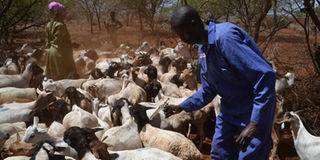Deadly goat plague meets match in mobile phones, disease monitors

A veterinary officer vaccinates livestock in Laisamis. Goat plague affected livestock in Turkana and Marsabit regions late last year and beginning of this year and researchers are using mobile phones to fight the disease. PHOTO | ISAIAH ESIPISU | NATION MEDIA GROUP
What you need to know:
- Goat plague is a disease characterised by sudden onset of depression, anorexia, fever, purulent discharges from the eyes and nose, disturbed breathing and coughing and foul-smelling diarrhoea that leads to death.
- The researchers from Veterinary San Frontiers (VSF) Germany, working with livestock officers from Turkana and Marsabit counties, have enlisted selected farmers to become Community Disease Reporters (CDR) to enhance outbreak detection.
- Due to the close monitoring and early warning using mobile phones, only 6,000 sheep and goats have succumbed to goat plague in the last three months in Laisamis.
- The disease reporters are key in the success of the fight against the disease given the limited number of veterinary technical staff, and the vastness of the county
On January 1, Leteriyon Ejeret, a resident of Turkana woke up to a devastating tragedy.
As people celebrated the New Year, 15 of his goats had succumbed to a “strange” disease that was later identified as goat plague, also known as Ovine rinderpest or peste des petits ruminants (PPR).
The fatal viral disease affecting sheep and goats was first reported in Turkana in 2007, and has since wiped out hundreds of thousands of livestock in the entire northern region.
Goat plague is a disease characterised by sudden onset of depression, anorexia, fever, purulent discharges from the eyes and nose, disturbed breathing and coughing and foul-smelling diarrhoea that leads to death.
While Ejeret’s animals had shown some of the signs, he did not know that it was the fatal disease.
Now researchers have come to the rescue of farmers like Ejeret and are using mobile phones to fight the disease.
The researchers from Veterinary San Frontiers (VSF) Germany, working with livestock officers from Turkana and Marsabit counties, have enlisted selected farmers to become Community Disease Reporters (CDR) to enhance outbreak detection.
“Once we get a report via the mobile phone like the one we received when Ejeret reported death of his animals, we request the CDRs to sermon all herders from rangelands to avail their animals at a common place so that we can isolate and treat the sick ones, and vaccinate the rest,” said Michael Baariu, the veterinary officer in Laisamis, Marsabit County.
VSF Germany purchased mobile phones for 42 disease reporters in Turkana and Marsabit to enable them have direct contact with the county government veterinary offices.
“We have also put our vehicles on standby for response to any animal disease emergency. It is like a livestock ambulance service,” said Dr Stef Kimondu of VSF Germany.
SHARE THE LIMITED WATERING POINTS
Due to the close monitoring and early warning using mobile phones, only 6,000 sheep and goats have succumbed to goat plague in the last three months in Laisamis.
This, according to Baariu, is a negligible figure compared to thousands of animals that died before the control measures were put in place.
Turkana and Marsabit counties are home to millions of goats and sheep, the main source of livelihoods, with goat plague mortality rate estimated at 90 per cent.
The disease spreads faster during drought, as it is currently, mainly because animals share the limited water drinking points, therefore, if one is infected, there is a high possibility that the contagious disease will easily spread to others.
During the dry spell of 2011, Turkana West residents lost thousands of goats to the disease.
“I lost 150 animals in less than a month,” said Ramathan Ekai, also a trained CDR from Turkana and a pastoralist keeping 280 goats and sheep.
Simon Lamor from Songot village in the county said he lost some 100 mature goats and sheep, while Sellina Naperi, another resident lost 40 goats out of 70 she owned.
“Goat plague has been the biggest nightmare for residents,” said Johnson Wamalwa, the chief livestock officer in Turkana West sub-county.
CONCERTED EMERGENCY RESPONSES
“But with herders involved in monitoring and reporting deaths and symptoms, I am confident it will soon be eradicated,” he added.
It was through such concerted emergency responses at national and international levels that Rinderpest (cattle plague), a deadly viral disease affecting cattle, other cloven-hoofed animals such as oxen and sheep, and some wildlife species was completely eradicated by 2010.
Kimondu says community disease reporters have enough training on how to identify symptoms of the disease in an animal and how to isolate sick ones as the first control measures.
“The disease reporters are key in the success of the fight against the disease given the limited number of veterinary technical staff, and the vastness of the county,” said Baariu.





